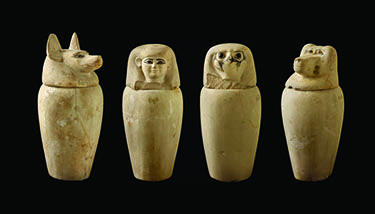I love poring over photographs of the treasures of King Tut and the Egyptian Museum of Cairo: the exquisite furniture, the alabaster jars for face cream, the gold leaf and agate bracelets.
You look at this stuff crafted 5,000 years ago and then you look at, say, a balloon dog by Jeff Koons, and you think: What happened to us?
Anyway, speaking of Egypt, we now have an exhibit at the Natural History Museum called “Mummies: New Secrets from the Tombs.”
“This exhibition features mummies from Egypt and Peru. It includes the human remains of adults and children, including some that are unwrapped or exposed,” reads the disclaimer.
I mean, who wouldn’t be on board for that?
I made my way down on a weekday morning. Security is tight. The darkened rooms were crawling with college-prep 3-year-olds lisping, “These are awtifacts” and “Mommy, why did they have to be bewwied?” at full voice.
Peruvians, the oldest known mummifiers, used stone tools to remove the carcass’s skin, deflesh the bones, and remove organs. Then they reattached the skin — which in the meantime they’d tanned — painted the mummy black or red, clapped on a wig, and covered the face with a clay mask.
Folks kept these mummies in their homes or carted them to festivals. Peruvian mummies were buried sitting up. Huddled together and gazing outward, one family looked as if they were patiently awaiting the advent of TV.
Like us, these ancient cultures used music, drugs and food to combat the harshness of life. Peruvian mummies were often buried with flutes, cups of coca leaves, vessels of chicha — corn beer — and dishes piled with beans, spices and fish.
Also like us, they preferred that someone else do the chores. Many Egyptian mummies were buried with shabtis — small ceramic figurines of slaves. If the loved ones couldn’t afford ceramic, they’d fashion a servant or two of mud.
It was the Egyptians who brought mummification to a high art.
“Egyptians used mummification to halt the natural process of decay, sometimes preserving a person’s body for thousands of years after their death. Organs that would hasten decay — liver, lungs, intestines and stomach — were removed. The heart, believed to be the seat of both intellect and emotion, often stayed in place, as it would be necessary for the afterlife.”
The brain, deemed to have no use, was removed through the nose.
Layers of astoundingly tightly- and beautifully-wrapped linen strips were then glued in place with resin. Many mummies sported gilded masks, since Egyptians believed “that in the afterlife the dead would need their faculties of eyesight, hearing, taste and smell, and masks allowed them to retain these senses.”
Wooden coffins were painted with hieroglyphics, often from “The Book of the Dead,” a collection of funerary texts. The rich further guarded against grave robbers by encasing the coffin in a stone sarcophagus, and burying the whole thing in sand.
They couldn’t guard against the depredations of 21st century technology. The lesion on a man’s vertebrae reveals that he was infected with tuberculosis. That an ibis’ last supper consisted of grain — not an item regularly found on an ibis’ menu — shows that he or she was probably one of the millions of animals raised for the specific purpose of being killed and mummified, too.
Most Egyptian gods were associated with animals, so these mummified birds, baboons, jackals and gazelles were sold as religious offerings. The PETA brigade would have a collective coronary at the wee crocodile mummy, encased in an astonishingly intricate, segmented linen-and-canvas shroud.
“As technology progresses,” reads one placard, “it gives archaeologists increasingly detailed methods of examining and understanding the dead.”
Well, yes and no.
These human remains have been poked and prodded, the heads torn off and thrown aside by grave robbers, their belongings picked over and plundered; their bodies X-rayed, CT-scanned, and now exposed to the curious eyes of 21st century Angelenos.
We can examine mummies at the cellular level. We can analyze their DNA. But for all that, their deepest secrets remain hidden. Did this girl who died so young prefer blue or green? What thoughts ran through the head of this elderly man from 700-600 B.C. as he looked at the stars at night?
By 250 A.D., Egypt was under the rule of the Roman Empire. Beliefs changed. Mummification practices died out.
Still, looking at these desiccated bits of human flesh — a bone, a rotten tooth — I’m not sure we’ve come that far.
During the last days of her life, in January, 2013, a 23-year-old cryogenics devotee named Kim Suozzi arranged to have her brain frozen. Her boyfriend Josh Schisler was on board, too.
According to a recent New York Times article, “Family members and strangers alike told them they were wasting Kim’s precious remaining time on a pipe dream. Kim herself would allow only that ‘if it does happen to work, it would be incredible.’”
It was left to Kim’s father to bear the hard news: “Dying,” he told her gently, “is a part of life.”

